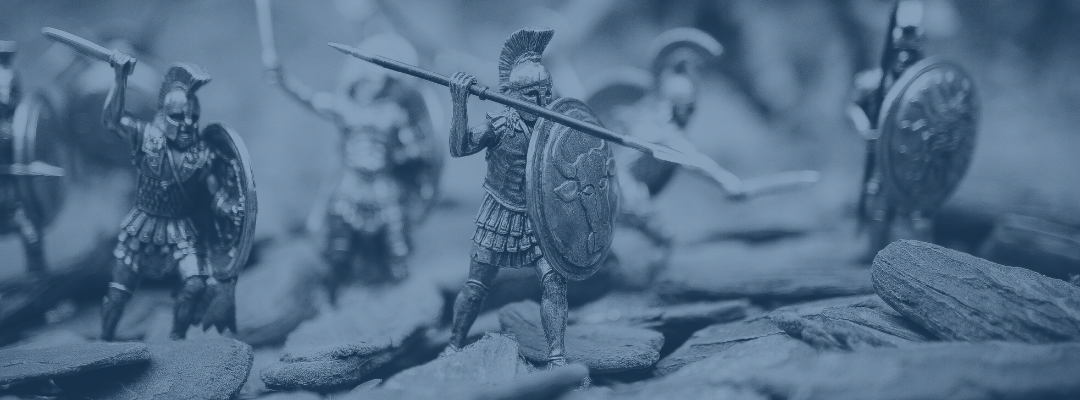If you hate cold-calling, cold-emailing, and want to stop chasing people to sell them something, you must become your niche’s go-to thought leader. Doing so will lead people to come to you.
Learning about the best way to market yourself will get you closer to that goal. In this article, we will share some insights on how you can do so.
These insights come from the top strategists in history. Some of these insights were used to create the biggest empires in the history of our planet. Even though you won’t be fighting battles with swords or gunpowder, you will be doing so with content. And the territories you will conquer are not physical, but digital and psychological.
To become a go-to thought leader, you need to dominate certain keywords and topics with the ultimate goal of conquering certain thoughts and emotions in the minds of your audience and ideal clients.
Keep reading to learn more about the best way to market yourself with content.
Contents
Conquer Your Mind Before Conquering Your Niche
Most of the greatest military victories in history have a notable difference when compared to regular victories.
In many famous battles, there is a significant discrepancy in the number of troops lost by each side, with hundreds on one side and thousands on the other. This puzzled military strategists, who then investigated further. Upon closer examination of these battles, it became apparent that the differences were due to the winning army being able to ambush the enemy and disrupt their defenses. When the defensive lines were broken, the separated small groups would feel isolated, and this caused them to panic, drop their weapons, and start running.
And it’s no secret that killing a soldier is easier when he is running away from you.
Keep in mind that in ancient warfare, most combat was hand-to-hand. Individuals were exposed to death from all directions. For this reason, good strategists trained their troops to remain as close as possible during battle. And the Romans perfected hand-to-hand combat by placing the youngest fighters in the front lines, the best fighters in the back, and the rest in the middle.
By doing so, they limited the possibility of panic arising amongst the young fighters because they were surrounded by braver and more skilled fighters.
This made the Roman Legions some of the most cohesive fighters in the world at that time because each fighter could completely focus on the enemy in front of them without having to worry about being attacked from the sides or from behind. It’s clear then that most of these lopsided battles were much more psychological than physical. And it’ll be the same when you decide to build your personal brand in order to dominate your niche as a thought leader.
The most important battle is the one going on inside your head.
More than 80% of self-talk is negative and you’ll have to constantly fight that bias. A great way to avoid letting negative self-talk and doubt get in the way of the success of your personal brand is to have a long-term plan with clear metrics of success. And you must also have key performance indicators that you can check in the short term to make sure you are going in the right direction.
Doing so will allow you to minimize the doubts and the fear that will likely arise during the first phase of building your personal brand.
It will take time for the Google and YouTube algorithms to pick up your content. Depending on the level of competition in your niche, it might take several months to get to top rankings and see the views transform into website visitors and leads generated. While this happens, others might say that it’s ridiculous to think that you’ll get clients by posting videos on YouTube, writing blogs, or sharing content on social media.
This is when your strategy and data will serve as those experienced warriors surrounding the young warriors.
You will not flee, because the strategy, the data, and the milestones you are hitting will keep you focused and confident that victory will be achieved.
You must conquer your mind first if you want to conquer your niche as a thought leader.
Your Personal Brand Strategy, Your Personal Decisions
One of the most important rules of warfare and leadership is having unity of command.
Frederick the Great, king of Prussia, once outfought five great powers which were aligned against him in the Seven Years’ War. He was able to do so because he made decisions much faster than the alliance generals, given that they had to consult with each other in every move they made.
The advantage of a personal brand is you don’t have to consult anyone.
Getting insights and feedback from your team, consultants, or coaches is always a good idea. Yet, you have the final word, and you can go from idea to execution much faster than most of the other players in your niche. In the business world, big brands move slowly. There’s usually a lot of red tape between opportunities and taking action to capitalize on these. This is a great opportunity for people who have the ability to move fast.
Your personal brand. Your personal decisions.
Make them as quick as possible to capitalize on opportunities.
Delegate, Trust, and Conquer
Karl Mack was an Austrian quartermaster general and an influential member of the Austrian military. In 1800, he was advocating for a preemptive strike against France.
“In war the object is to beat the enemy, not merely to avoid being beaten.” – Karl Mack
The campaign Mack was leading for that preemptive strike (started in September) got him along the Danube towards Ulm, deep in the heart of Bavaria. He was so advanced in this transition that if Napoleon (leader of France) sent troops across the Rhine into Germany and Bavaria, the Austrians would know and would take action to slow him down. It was calculated that Napoleon’s 70,000 men army would take about two months to get from the Rhine to Ulm and by that time, the Austrians would’ve linked up with the Russians and easily taken Alsace and France.
It was a great strategy on paper. But by the end of September, Mack realized something was off.
Out of nowhere, his scouts were sharing information about a French army that was passing through the Black Forest (located to the west of Ulm). This didn’t make sense, as the best move for Napoleon was to cross the Rhine into Germany farther to the north. Even if this move through the Black Forest was a decoy, Mack had to move troops to defend his position. He had to send part of his army west into the Black Forest. Some days later, another scout report shared information about a large French army somewhere north of his position. Some said at Stuttgart, which was 60 miles northwest, but others said that it was north but way closer to Ulm. Mack, letting confusion take over him, decided to order all his troops back to Ulm to concentrate forces.
Later, the scouts were able to confirm what had actually happened.
There was a French army blocking Mack’s way back to Austria and cutting off the Russians at the same time. The army had crossed the Danube to the east of Ulm. Mack couldn’t understand how this was possible. He was about to panic but realized that there was a weak point. The northeast was protected by a small French force. As he began to prepare to march in that direction, scouts reported a large French force appeared overnight, and was blocking the northeastern route.
Later, Mack discovered that the Russians had decided not to send troops, and on October 20th, he surrendered.
More than 60,000 Austrian soldiers were taken prisoner with almost no shots fired. This has been recognized as one of the biggest bloodless victories in history. Napoleon was able to pull this off because of a particular strategy he was leveraging. No one else was using it at the time. It consisted in dividing his army into several “mini-armies.” Instead of moving a whole army of 210,000 men, Napoleon would divide it into groups of 15,000 to 30,000.
The trick was that each of these groups had its own cavalry, infantry, artillery, and general staff. Making each group a miniature version of the whole army, headed by a miniature Napoleon.
This fluid style was what allowed each of those groups to move around Ulm, making it seem from Mack’s perspective that Napoleon had more than 70,000 men available.
There’s much to learn from this historical event that we can apply to our personal branding strategy.
If we want to conquer our niche and become the go-to thought leader, we must delegate and trust the team we work with.
Whether that is an internal team, a personal branding agency, or a personal branding consultant you are partnering with, you must build processes so that not all actions have to be approved by you.
By building personal branding guidelines, personal brand voice guidelines, and personal branding templates, you can delegate much of the content creation process while you focus on the big picture.
Nobody Else Will Understand Your Plan
Napoleon faced Mack again in September 1805 and this time, Napoleon seemed to be in great danger.
His men were hungry, tired, and short on supplies. Retreat seemed like the best option, and all his generals were advising him to do so. On November 25, some of Napoleon’s troops were reported to start moving into a position that indicated preparation for battle. And this didn’t make sense because his troops were outnumbered two to one. The Austrian and Russian leaders were surprised when Napoleon seemed eager to come to terms after seemingly making preparation for battle.
At this point, the Czar and his generals thought that Napoleon was panicking and trying to minimize his losses.
The suspicions seemed to be confirmed when Napoleon abandoned a strong position he had recently taken (Pratzen Heights). He appeared to be confused. Then, he asked for a meeting with the Czar. But the Czar sent an emissary who reported that Napoleon was clearly full of fear and doubt. Still, they were not able to agree to terms and were set to start the battle. As the battle began, the Austrians and Russian were dominating and pushing deeper into French lines. Right when it seemed the battle was almost over, news arrived of a large French force that was heading their way and, given their current position, would soon end up surrounding and isolating the Austrians and Russians.
The defeat was so great that the Austrian and Russian alliance collapsed.
Napoleon was able to turn this situation around and this became one of the greatest triumphs of his career. From everyone else’s perspective, Napoleon’s move didn’t make sense. But from his perspective, it was all part of a winning strategy. The same will happen when you start building your personal brand.
As you start sharing content, people will criticize it.
Your friends, family, and colleagues will start sharing their opinion and it might not always be positive. People will say that you are putting your career in jeopardy or that you might hurt your reputation within the company. Some might say that you are too old for social media. And the list goes on and on.
They will say you are confused, as they did with Napoleon.
You must trust your vision and strategy. Sooner than later, everyone will realize that your personal brand will be the asset that leads you to the greatest triumphs of your career. And for the other competitors in your niche, it will be too late when they realize that you have become the go-to thought leader.
Play the Long Game
During the Seven Years’ War (1756-63), Frederick the Great of Prussia was facing immense challenges and obstacles.
He was battling against Austria, France, and Russia. At the same time. Frederick gained his fame as a great military strategist with aggressive attacks. But this time, it seemed he would have to embrace the defensive position. All he did was focus on buying time. All he was trying to do is live to fight another day.
Suddenly, Czarina Elizabeth of Russia died. Her nephew and successor, Czar Peter III, did not like his aunt and admired Frederick the Great.
Peter made the decision to not only stop the war but to ally himself with Frederick the Great. It seemed like a miracle. Investing in building a personal brand might be one of the best career moves you have available, as it is an asset that you can fully control.
Yes, it will take time to build.
And at times, it might seem difficult to keep going as you’ll probably face pressure from different fronts, as Frederick did. You might have to deal with criticism for people who watch your videos and other content, and don’t like it. You might also have to deal with pressure from colleagues because they might think that you are wasting time. They might say you should be setting meetings, doing calls, or “trying to get your name out there” in other ways, such as networking.
You might even have to deal with your family putting pressure on you. They might not understand why you are dedicating extra time to work on your personal brand, outside of the time you are already dedicating to your job.
But once you get enough momentum going, it’ll be unstoppable.
And the growth of your personal brand, to everyone else, will seem like a miracle. Everyone will say it’s an overnight success.
Let everyone else keep saying whatever they want to say, while you focus on dominating your niche, then your industry, and why not, dominating the world.
Groom Yourself For Greatness
Alexander (356-322 B.C.) was able to reach greatness because he was groomed for greatness.
His tutor was Aristotle. His mother, Olympias, was a mystical woman who had visions at Alexander’s birth. The visions showed Alexander as the ruler of the world. She believed his son was destined to be as great and famous as Achilles, from whom her family claimed descent. All of this influenced Alexander. And from early in his life, he started to carry himself as if he was more than the son of a king.
Think about that… What can be higher than being born as the son of a king?
Whatever that was, Alexander was groomed to believe he could achieve it.
You must surround yourself with people who believe in you and support your decision to build a personal brand. Find a coach, find a mentor, and find other people who are investing in themselves and their personal brands. Better yet, find all of these and make them part of your inner circle. Your own personal board of advisors.
It’s critical that you surround yourself with people who support your vision of greatness.
You’ll face enough challenges when working on getting your message across through the content you create. You don’t need the extra negativity that some people can bring to your inner circle. Only people who share your vision must be allowed in that inner circle. But this doesn’t mean surrounding yourself with cheerleaders and “yes people.”
I’m sure Aristotle didn’t go easy on Alexander.
What you want is people who are rooting for you and your success. People who will give you tough love as you build a personal brand that will allow you to achieve all of your professional goals. And who knows, some might even start to call you the King or Queen of <insert your niche here>.
Fight Without Fighting to Win the War
One day in Japan in 1540, there was a young samurai telling stories in a ferryboat.
He was telling everyone about his great victories, while also maneuvering his sword around to demonstrate his prowess. The passengers weren’t that interested, but they were afraid, so they acted as if they were interested in the stories this young samurai was sharing.
Only one person didn’t seem interested—an old man sitting by himself and ignoring the young samurai.
The older man was noticeably a samurai as well because he was carrying two swords. What no one knew is that he was Tsukahara Bokuden, known as one of the greatest swordsmen in Japan. The old man sat with his eyes closed, meditating. This irritated the young samurai because he wanted all the attention he could get.
When he couldn’t stand it anymore, he said to Bokuden, “Don’t you like this kind of talk? You don’t even know how to wield a sword, old man, do you?”
“I most certainly do,” answered Bokuden. “My way, however, is not to wield my sword in such inconsequential circumstances as these.”
“A way of using a sword that doesn’t use a sword,” said the young samurai. “Don’t talk gibberish. What is your school of fighting called?”
“It is called Mutekatsu-ryu [style that wins without sword fighting],” replied Bokuden.
“What? Mutekatsu-ryu? Don’t be ridiculous. How can you defeat an opponent without fighting?”
Of course, the young samurai was irritated and challenged Bokuden to a fight. But Bokuden refused to fight in such a crowded space with innocent people. He said they could fight as soon as they reached the nearest shore, and he asked the ferryman to take the boat to the nearest island. The young man began warming up and stretching while Bokuden remained sitting with his eyes closed.
As they got close to the island, the young samurai jumped out of the boat and started calling Bokuden out, “Come! You are as good as dead. I will show you how sharp my sword is!”
Bokuden took his time, which annoyed the young samurai, who kept screaming and acting tough.
Then, Bokuden handed the ferryman his swords, saying, “My style is Mutekatsu-ryu. I have no need for a sword,” and as he said that, he took the ferryman’s long oar and pushed it against the shore, which sent the boat out into the water and away from the island.
Of course, the young samurai screamed and demanded they return to fight. Bokuden shouted back, “This is what is called victory without fighting. I dare you to jump into the water and swim here!”
And just like that, the battle was won without fighting.
In your quest to dominate your niche as a thought leader, it is important to identify the battles that you need to avoid.
This is especially important when picking the topics and keywords you want to rank for. It’s key that you start with keywords that don’t have a lot of competition.
Or keywords that have low-quality content ranking at the top.
This way, you’ll start picking up easy wins to build the necessary momentum and authority to later on go for bigger and more valuable keywords.
And who knows, once you are dominating your niche, you might win some keyword battles without fighting at all because others will start to avoid the keywords you dominate.
They’ll see your content and know it’ll be almost impossible to create a piece that outranks it.
The Best Way to Market Yourself
If you liked these insights about the best way to market yourself, and are hungry for more, then I have good news for you. There is more.
For more personal branding insights from historical figures who almost dominated the world, you can read the top 13 personal branding strategy tips from Napoleon Bonaparte.
Whenever you are ready to start creating your personal branding strategy, you can apply to book a complimentary consultation with us.
And if you just want more historical war stories, I’d recommend you read The 33 Strategies of War by Robert Greene.





